The Palestine Question has a peculiar characteristic: It is like a constantly-running play, much longer than the “mouse-trap”, only more tragic. The players change, but the same story goes on.
If you missed all events since WWI, you must have seen the carnage in Gaza last January. This is a replica of past events. It brings us back to the beginnings.
In the wake of WWI, The League of Nations bestowed upon Palestine its “Sacred Trust of Civilization” by which Palestine was put under Mandate class A; that is, it is fit for independence as soon as the Mandatory power, Britain, would finish its task of helping Palestine to build its institutions. This task is not finished till today and Palestine remains under the guardianship of the United Nations and its responsibility.
Why was not the task finished after 92 years? It is because those powers who promised applying the “Sacred Trust of Civilization” are the same who betrayed it. The guardian became the villain. As a result, the Palestinian people suffered the longest war ever waged against a people, 92 years and counting, with the objective of depriving them from their patrimony and inalienable rights.
The Mandatory Power, Britain, represented by Herbert Samuel, the Zionist first High Commissioner in Palestine, established in his first term, 1920-1925, the legal foundation of the components of the State of Israel. Moreover, in the following 28 years, the British Mandate allowed Jewish European immigrants into Palestine, thereby increasing Jewish population from 9% to 30% of total population. More ominously, Zionist Jews built an army of 120,000 soldiers by the end of the Mandate, or 20% of all Jews, which is 15 times the ratio in any country. This number of soldiers is comparable to the American forces in vastly bigger Afghanistan. In 1948, they bounced on Palestine and carried out the largest, longest, pre-planned and continuous ethnic cleansing operation in modern history. That was al Nakba.
Slide-1: Al Nakba Anatomy
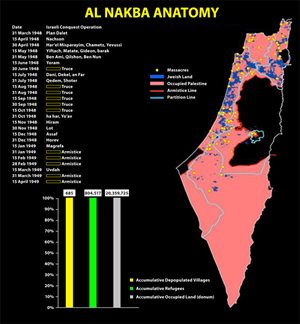 Slide-1
Slide-1
The blue areas are lands acquired by the Jewish immigrants during the Mandate to the tune of 5% of Palestine. The red area are conquered Palestinian land. On 15 May 1948, when he declared his state, Ben Gurion was in control only of 13% of Palestine. Zionist militias committed one half of the massacres in this period.
The Israeli conquest went on. Seven thousand square kilometers in the south were occupied by Israel after it signed the Armistice Agreement with Egypt. Within six months Israel occupied 78% of Palestine, it was established a land of which 93% is Palestinian.
Slide-2
This shows the occupied land. What about the people?
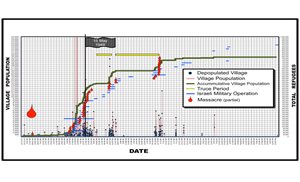 Slide-2
Slide-2
The first thing Ben Gurion did was to expel the Palestinian citizens of the state he planned to establish. This is called ethnic cleansing. Half of all refugees were expelled before the state was established, while the British were watching, not rising to their obligations. That is before any Arab soldier entered Palestine to prevent expulsion and massacres. This explodes the myth that Israel was in self-defence.
The expulsion went on. 675 towns and villages were depopulated. Every expulsion was correlated with an Israeli military operation of conquest. When there was truce, no body left, as you can see from the yellow line. If they left on Arab orders, the truce or the lull in fighting would have been a good time to pack and leave but they did not, as you can see in the flat green curve. This explodes the myth that exodus was not initiated by the Israelis.
A damning proof is the occurrence of over 70 massacres. Every Israeli operation was accompanied by one or more massacres. As you can see these massacres coincided with the exodus and the military operation. In the end, 800,000 refugees lost their homes. They are now about 7 million refugees, of which 4.7 million are registered refugees with the UNRWA and under its care. That is why UNRWA exists and remains until its job is done.
A distinguished man of peace who saw this tragedy and felt its impact was Count Folke Bernadotte, the UN Mediator in Palestine. Jewish terrorists assassinated him on the day of his final report. They were too late. His report and his legacy became the corner-stone of the famous UN resolution 194.
This resolution, affirmed by the international community over 130 times, more than any resolution in UN history, has three main components:
- It calls for the return of the refugees and their compensation.
- It calls for their relief and assistance until they are repatriated.
- It creates the mechanism for the resolution’s implementation, the UN Conciliation Commission for Palestine, UNCCP.
Not only Resolution 194 was the central pillar of international law, but it was, over the years, the fundamental demand of the refugees.
I would like to read for you a paragraph, from a letter I found in Philadelphia archives, sent by a field officer in Gaza of the American Friends Service Committee (the Quakers), one of the first relief organizations to come to the assistance of the Palestinian refugees. His letter to his Philadelphia head-office was dated October 12, 1949: (mark the date).
Since it is very difficult for refugees here to communicate with the outside world, we feel we have an obligation to convey what we can of their opinions and thinking at the present time. They feel strongly that the United Nations are responsible for their plight and therefore have the total responsibility to feed, house, clothe and repatriate them... Above all else, they desire to go home–back to their lands and villages which in many cases are very close... Without it, they would have nothing for which to live... It is as genuine and deep as a man’s longing for his home can be.
Today this is still echoed by the sons and grandsons of the refugees. A proof of this is our meeting here today organized by the Palestinian Return Centre.
Immediately after resolution 194, UNCCP negotiations to repatriate the refugees started in Lausanne from January to May 1949. By signing the Lausanne Protocol on May 12, 1949, Israel finally agreed to the partition plan (resolution-181) and the return of the refugees (resolution-194). But that was a trick. Under American threat, Israel agreed to these resolutions, only in order to gain admittance to the UN. Two days after Israel was admitted to the UN, Israel introduced conditions whose “main purpose was to undermine the Protocol of 12 May”, according to their representative.
This is a crucial date. The main American delegate, Ethridge, who insisted on the return of the refugees, resigned in disgust. The American position switched, since then, to the Israeli side and started talking of “economic”, not political measures, such as Marshal Plan based on Clapp’s Economic Survey. The aim was to settle the refugees in other Arab countries, not in Palestine. In December 1949, UNRWA was created, as a successor to previous relief organizations, but with one difference, to implement settlement of refugees away from their homes. In other words, it was given the task of the perpetuation of the ethnic cleansing carried out by Israel. Israel in its turn did not waste time. Just weeks before UNRWA started operations in May 1950, feeling immune from international pressure to allow the return of the refugees, Israel promulgated its all comprehensive, legally-false Absentees’ Property Law to seize and confiscate all refugee property.
The change of course in UNCCP direction, instigated by the Americans to make UNRWA a tool of Israeli policy, continued over the following 6 years or so. Missions came and left, with offers of untold millions, clever division of Arab waters, discrete and indiscrete pressure on host countries, all with the aim of carting away the refugees from their homes, property and country. But all this failed. In the nineteen fifties the refugees themselves destroyed UNRWA stores and demonstrated at distribution centers, shouting: “We do not want your food or money, we want our homes back”.
Fedayeen groups started to operate in the Israeli occupied territory of Palestine and secret national societies were formed, leading 10 years later to the PLO.
How then UNRWA became the “unsung hero”? By virtue of its Mandate, its dedicated international and local staff and by the resilience of the Palestinian people.
First and foremost, UNRWA kept a valuable record of each refugee, his name, his village of origin, his family members, his place of exile. Para-20 of Resolution-302 creating UNRWA Mandate stated that:
“The UN directs UNRWA to consult with UNCCP in the best interest of their tasks with particular reference to para-11 of Resolution-194”. That is, to preserve the identity of Palestinians and to protect the rights of the refugees to return to their original homes.
That is one reason why the Israeli members of the US Congress constantly attack UNRWA, because of its mandate to observe UN resolutions. Those Congressmen turn a blind eye when Israeli children are taught to hate the Arabs and their rabbis issue edicts to kill non-Jewish children and women, but chastise UNRWA for allowing the refugees to remember their villages in Palestine. What the Quakers’ officer called “a deep and genuine longing for man’s home” is described by pro-Israel advocates as “incitement to Israel’s hatred”.
UNRWA staff served the refugees through hell and high water, through the wars of 1956, 1967, 1982; through the massacres of Khan Younis and Rafah camps in November 1956, through Sharon massacres in al Bureij camp in 1953 and in Sabra and Chatila camps in 1982, through the atrocities in Jenin camp in 2002, through the hardships of the intifada, curfews and closures. Many of its staff were killed, wounded, imprisoned or abused by the Israelis.
Not once through its 21,779 days of operations till today did UNRWA staff waver in their duties of providing food, shelter, medicine and education, even while Israeli planes and tanks were dropping their venom on the Palestinians. Their high officials, like Peter Hansen, Karen Abu Zayd, John Gings, were standing with the victims of the bombardment, on the rubble of their homes, minutes after the Israeli destruction.
UNRWA worked with a meagre budget. Western powers originally paid generously, to alleviate the pressure of international law on Israel to allow the return of the refugees, by finding a home for the refugees anywhere in the world except their homes. They saw refugees as “a source of instability” which had to be damped down.
But the interest of Western powers in supporting UNRWA has dwindled recently, meagre as it was. Without distracting from Sami Meshasha, UNRWA spokesperson presentation this afternoon, who will no doubt talk about UNRWA’s budget, I may say a few wor ds on that, perhaps more plainly and less diplomatically than his position will allow him to do.
According to UNRWA budget for 2008, UNRWA spends, from funds received from UN member states, the amount of $76 per refugee/per year, that is 20 cents/day, for its Regular Budget. But it also spends a further $40/year for its Non-Regular Budget. What is that? This Non-Regular Budget was created to meet new disasters, such as Israel’s destruction of houses and killing of civilians and further destitution of Palestinians, such as the recent assault on Gaza.
The US pays 27% of the Regular Budget, that is 6 cents per day per refugee, but it pays almost 50% of the Non-Regular Budget, that is 5 cents/day per refugee to rebuild the destroyed UN schools and burnt UN stores, a feat achieved by the Israeli Airforce and tanks, assisted by American supplied F-16 planes and white phosphorous bombs.
Not only in terms of armament the US is over-generous in aiding Israel. The US pays about $1000 per Israeli per year (against $40/Palestinian), equally divided between economic and military aid.
The US further aggravates the problem by assisting Russians to immigrate to live in Palestinian homes. The outcome of this policy is that Israel now has a nightclub bouncer as its foreign minister. Since the nineties, the US paid Israel $50-80 million per year for its Russian immigrants, or a total of $ 1.0 billion. It pays a Russian immigrant 30 times what it pays for a Palestinian refugee.
What about the UK, Balfour’s country? The UK government pays 10% of the Regular Budget ($37 million) and a $ 20,000 for the non Regular Budget. Morally speaking, this is greatly dwarfed by the warm and determined support of the British people for the Palestine cause.
The European Commission pays considerable amounts to UNRWA and an additional amounts keeping PA institutions afloat in the face of brutal occupation in the West Bank and deadly siege of Gaza.
Knowingly or otherwise, the Europeans finance the Israeli occupation, by taking this responsibility on their shoulders which is the duty of Israel as the Occupying Power according to the 4th Geneva Convention. I wish the Europeans stand squarely to Israel and tell them what they already believe behind closed doors: “you are violating international law. Shape up, or else you shall face sanctions, boycott or even siege”. Unfortunately it is Gaza refugees who are under siege. Alas, The Europeans do not even have the courage to claim from Israel the cost of hospitals and institutions they built and Israel destroyed.
On behalf of the Quartet, Blair offers financial and political bribes and the added incentive to lift the siege on Gaza and the barriers in the West Bank if only Palestinians forget Palestine and accept Israel’s conditions.
It is only political expediency which led to these offers in the name of the Quartet. For the Quartet has no legal authority contrary to international law. Alvaro de Soto, the UN mediator on Palestine, the successor of Count Folke Bernadotte 60 years later, stated recently in his Final “End of Mission”
Another public misunderstanding is the characterization of the principles laid down by the Quartet as “conditions”, which, until they are met, stand in the way of contacts and assistance to PA… The Quartet has never once referred to the principles–nonviolence, recognition of Israel, acceptance of previous agreements–as “conditions”. While they appear as conditions for two Quartet members–the US and the EU–this is due to their own legislation rather than a Quartet decision.
It seems that Blair is not only facing accusations about engineering the Iraq war, but also he may be accused of using the Quartet as an instrument of Israeli policy. De Soto says as much in the same para:
Russia and UN are used as a shield for what the US and the EU do.
The question arises then: how long should the Palestinians endure this situation? They already suffer from the longest war in history waged against a people. Many Balfours came and went but his legacy remained. Its fiercest manifestation can be seen in Ben Gurion, Sharon and Netanyahoo, to name a few. No remorse, no mercy, but relentless pursuit of the same aim: to annihilate the Palestinians politically, geographically and historically.
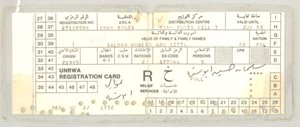 Slide-3
Slide-3
During all those years, we had peace emissaries, commissions and missions: Johnston, Jaring, Rogers and after 1967, assortment of Israelis. Then came the biggest hoax of all: Oslo. If you count them, you will find 50 or 60 proposals or plans by western and Israeli politicians since 1948. Not one of them, not a single one, complies with international law or UN resolutions. All of them accept the Israeli position of ethnic cleansing, apartheid or occupation, but try to find ways to make this pill palatable to the Palestinians.
Like Blair with his ever-ready promise of cash, wrapped in an expired political message, western politicians failed, after all these years, to grasp a simple fact. It is far cheaper, more lasting, and more honorable if that is a criterion, to repatriate the refugees, than to hand out donations to Palestinians and war materiel to Israelis.
-
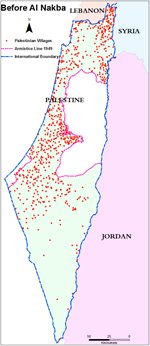 Slide-4A
Slide-4A
-
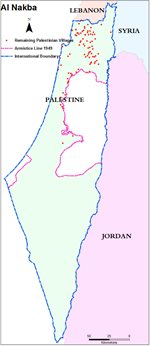 Slide-4B
Slide-4B
-
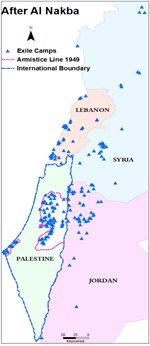 Slide-4C
Slide-4C
But we do not have much hope there. The hope lies, and remains, with the Palestinians and those good people around the world who support them.
The perseverance of the Palestinians in their quest to return home is enhanced by the increasing world support and also by the work of UNRWA and its records. These records are the building block of the Return Plan. This simple card [Slide-3] is the genome of the refugeehood. It defines the refugee’s name, his family, the new families of his off-spring, his home in his village of origin and his camp of exile. The whole home-exile odyssey is imprinted in history.
It starts with where the refugee lived before al Nakba. [Slide-4A] Then the Nakba came, an event unprecedented in Palestine’s 5000 year history, [Slide-4B] life was extinguished from Palestinian landscape. This is where they were exiled. [Slide-4C] This refers only to the Registered Refugees under UNRWA’s care (4.6 million in mid 2008). There are (2 million) unregistered refugees. Total is: 6.8 million refugees, or two thirds of all Palestinians. If we include those displaced after 1967, we find that three quarters of Palestinians are forced to live away from their homes.
-
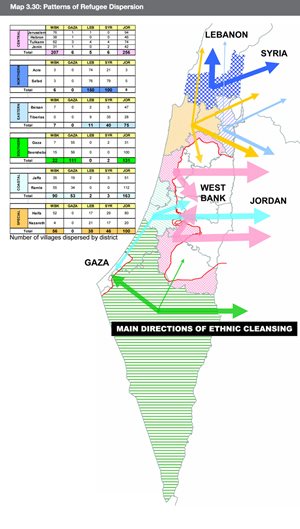 Slide-5
Slide-5
-
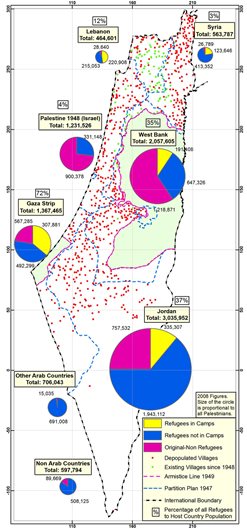 Slide-6
Slide-6
This is the route of their ethnic cleansing. [Slide-5] The Palestinians today are coming close to 11 million [Slide-6], about half of them are in Mandatory Palestine, equals roughly to the number of Israeli Jews. The rest are outside Palestine. But 88% of Palestinians are in Palestine and a ring around it, 150 miles wide.
Fortified by resolution 194, affirmed so many times by the UN and by fully documented Palestine: land and people, we can plan the refugees return.
To start with, we know where the people of each village were exiled to. We have three examples:
Slide-7A
Al Jiyya, in the south–mostly in Gaza Strip.
Slide-7B
Bayt Mahsir, west of Jerusalem–in the West Bank and Jordan.
Slide-7C
Saffuriyya, in Galilee–in Syria and Lebanon.
-
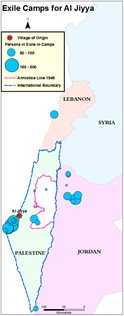 Slide-7A
Slide-7A
-
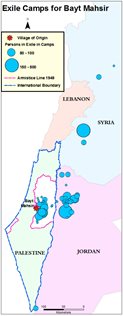 Slide-7B
Slide-7B
-
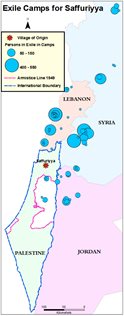 Slide-7C
Slide-7C
-
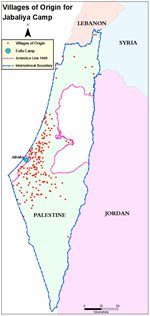 Slide-8A
Slide-8A
-
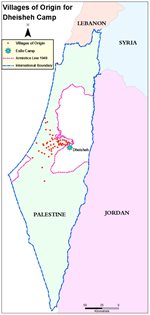 Slide-8B
Slide-8B
-
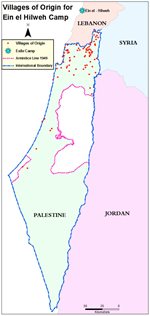 Slide-8C
Slide-8C
More importantly, we know how to repatriate them. For each exile camp, we know where its refugee come from. Take the case of Jabaliya camp, [Slide-8A]: which was pulverized by Israeli planes and tanks. Here is where they come from. The next camp is Dheishah [Slide-8B]: They belong to these villages west of Jerusalem. Next is a camp in Lebanon: Ein el Hilweh [Slide-8C]:, a constant source of the news. Its people came from Galilee.
We can go into much more detail. Take the Northern District of Galilee. We made a study of Israeli towns–who lives there now. We classified them into five categories [Slide-9A]: Then we allow the dispossessed people to return to their homes [Slide-9B]: As you can see, there is no problem of logistics or conflict.
-
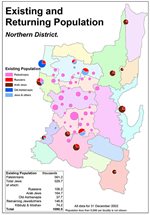 Slide-9A
Slide-9A
-
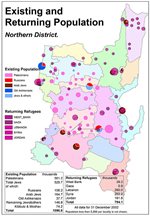 Slide-9B
Slide-9B
-
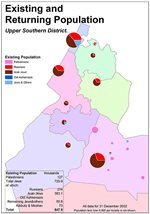 Slide-10A
Slide-10A
-
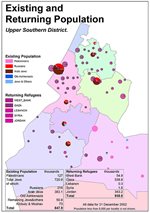 Slide-10B
Slide-10B
The southern district is much simpler. Apart from 3 originally-Palestinian towns, it is still largely empty. [Slide-10A]: The refugees in Gaza Strip can literally walk home [Slide-10B]:
This bring us to Gaza, the minuscule Palestine. Its area is 1% of Palestine. Its population is over 1.5 million, which the same number of all Palestinian in 1948. Why is it crowded? [Slide-11A]: Because the Israelis ethnically cleansed 247 villages and herded them into this small strip [Slide-11B]: (Sederot-Najd) They tried to finish them off in December 1948 in the battle of Hill 86 but they failed militarily. Since then they are still trying [Slide-11C]: This is a constant by committed war crime and a crime against humanity. Gaza starvation is a war crime. Rome Statute of the International Criminal Court art 8 (6) states: “War Crimes mean... [inter alia] starvation or impeding relief suppliers”. Gaza’s siege, starvation, cutting off supplies is Genocide. Art 6 para c of the same Statute says: “Genocide is... [inter alia] deliberately inflicting on the group conditions of life calculated to bring about its physical destruction in whole or in past”.
-
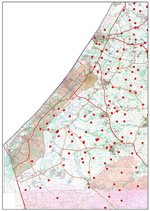 Slide-11A
Slide-11A
-
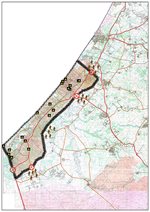 Slide-11B
Slide-11B
-
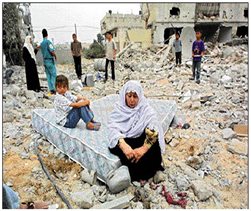 Slide-11C
Slide-11C
Should we allow this to continue? The answer is emphatically “No”. We, all of us, must work actively for the return of the refugees. Only when they return, when they are rehabilitated in their own homes, assured of decent living and safety from racism and apartheid, can we say the job of UNRWA is done.
Not only the return is an inalienable right, but as you have seen, it is also logistically possible.
Even the million and a half housing units to be built in place of destroyed villages, according to our study, can be built entirely by Palestinian hands. But there are more tasks to do: to rehabilitate the country itself and return the stolen goods, [Slide-12]?
 Slide-12
Slide-12
What is the legal structure necessary to activate the return?
All we need to do is to reactivate UNCCP to resume its duties to repatriate the refugees. This should be done by a binding Security Council resolution according to Chapter-7 of the UN Charter. Knowing the problems there, facing the US veto, we may need a General Assembly resolution under “United for Peace” formula. Or else, Israel’s conditional membership in the UN can be revoked for its failing to meet its conditions of membership.
UNRWA of course will be the main instrument for repatriation. It has a rich history and dedicated staff, ideal for the job.
What is the problem then? Of course, you know what it is. It is Zionism. If those in favour of colonialism, racism, apartheid and violation of international law, remain on the side of Israel, more war and suffering will occur and more war criminals will show up eventually at the Hague.
Slide-13
RETURN IS INEVITABLE
But if those in power learn from recent history, they should know that the shortest road to peace is justice. Let us follow this road. We, Palestinians, will never give up that road. We will continue to demand justice. And UNRWA remains a hero, demanding justice.
Thank you.